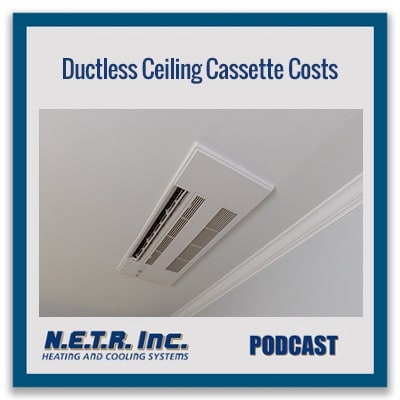
In this podcast, Brett Rogenski, General Manager of N.E.T.R., explains how much ductless ceiling cassettes cost. He talks about the factors that affect the costs of the equipment and the installation.
John Maher: Hi, I’m John Maher. I’m here today with Brett Rogenski, General Manager of N.E.T.R., Inc., a heating and cooling company in Massachusetts with a focus on Mitsubishi ductless heating and cooling products. Today, we’re talking about ductless ceiling cassette costs. Welcome, Brett.
Brett Rogenski: Hey, thank you for having me.
Do Ductless Ceiling Cassettes Cost More Than Wall-Mounted Units?
John: Sure. So Brett, did ductless ceiling cassettes generally cost more than wall-mounted units?
Brett: In general, they typically do. There’s a little more that goes into the installation of the unit, as well as the actual hardware costs. It’s a little more sophisticated piece of equipment being put in that packaging space. So the equipment’s a little more expensive and there’s a bit more labor involved in getting a proper installation.
Which Type of Ceiling Cassette Costs More?
John: And I know there’s two types of ductless ceiling cassettes. There’s one that’s longer and narrower that fits in between the ceiling joists. And then there’s a like a two foot square one. Which of those is more expensive?
Brett: Sure. Typically the square. So you’re absolutely right. There’s one that’s designed to fit between the joists. That’s about 15 inches wide by 43 inches long. It doesn’t require a lot of modification. As long as the joists are 16 inches on center, which is pretty standard. So that one, there’s not a lot of modification. There is a fair amount of work that’s done up above your ceiling because that’s where all the mechanicals are, and where the refrigerant lines are, et cetera. But the physical structure of the house doesn’t typically have to be altered much aside from carefully cutting the appropriate sized hole in your sheetrock in your ceiling to recess that.
The square one is a bit more expensive because again most homes are framed in a 16-inch on-center manner. And when we have to put in the 24, which works very well, we have to create a box. So we work with the homeowner and they either use someone or we provide someone a carpenter to come in, and create that 24-inch space, create a box for us to put that in so it maintains the structural integrity of the floor joists in the rafters. So a little bit of extra stuff in there.
John: Right. So the unit itself costs a little bit more and then also the installation costs more because of this extra, maybe carpentry work that has to be done.
Brett: Correct. That’s really the biggest driver there. A little more on the hardware, a bit more on the labor side shall we say.
Advantages of Ceiling Cassettes Vs Wall Mounted Units?
John: Okay. So do you feel like that’s worth it to the customer to to pay that extra for both the unit and the installation? What are some of the advantages maybe of a ceiling cassette over a wall-mounted unit that might make it worth the extra cost?
Brett: Sure. Well, two big advantages that come to my mind are that a ceiling-mounted unit is sending out conditioned air in either two or four directions depending on the unit . The square unit is sending out air conditioned air in all four directions, the rectangular goes in two directions.
So it can do a nicer job of actually cooling the room as opposed to a wall-mounted unit, which is blowing across the room. You have it mounted on one wall blowing across the area. A ceiling cassette can be mounted in or near the center blowing kind of omnidirectionally and then also drawing that return air up omnidirectionally. So they do an outstanding job with the cooling and the comfort.
The second part that’s really an enormous driver is the aesthetics of it. The functional components are hidden in a way above the ceiling. The grill is nearly invisible mounted up to the ceiling. It just kind of blends away and they allow the homeowner to keep that nice, clean aesthetic especially if you have open living spaces, open living room, kitchen, something like that, it gives it a much cleaner look, as well as being more comfortable and effective.
How Do You Install Ceiling Cassettes?
John: So I know that you can install one of these ceiling cassettes, the easiest way is probably to do it if you’re in a one-story home or on the second floor of a two-story home where you’re kind of cutting that hole and then putting the unit up into like an attic space that makes it probably the easiest to install.
I know that you’ve said that you can install ceiling cassettes on the first floor of a two-floor home sometimes. What are the situations where that is or may not be possible and does that add to the cost of installing a ceiling cassette? Does it make it more difficult if you’re trying to do it in the ceiling of the first floor of a two-story home?
Brett: Sure. So that’s a great question. Yeah, the second story is obviously simpler because we typically have an attic access above that or at least a crawl space. The first floor obviously, what’s above the first floor? The second floor. So the first thing we establish is which way are the floor joists running? And that tells us what direction we can access from the outside because we still need to access that space between those floor joists to run our refrigerant lines, et cetera, from the outside to the unit.
So we have to first establish can we get there where you would like the unit? Or if you’re saying, “Hey, I would really prefer one of these ceiling-mounted units on the first floor.” We may have to tell you where an eligible mounting location is, because we can’t get to every spot simply based on the facts of construction. But if folks are willing to be flexible with us, we can usually get to most spots. And then the other thing that we do and we work with the homeowner is before we commit to being able to put that on the first floor, we confirm that construction.
So a lot of times if you have recess lighting, we can pull out a recess light and confirm spacing on the joists. Occasionally we may have to ask you if we can cut a small hole, which would then be repaired to confirm that, again, the construction within those joists on the first floor because we can’t see it the way we would in an attic. So all those things kind of help determine how labor-intensive it is to put in based on the construction of your home. But if someone really wants one, more often than not, we can find a way to get there if they’re willing to be flexible with us on location on the first floor.
Contact NETR to Learn More About Ductless Heating and Cooling
John: All right, well, that’s really great information, Brett. Thanks again for speaking with me today.
Brett: Thank you. Thank you for having me.
John: And for more information, you can visit the N.E.T.R. website at netrinc.com or call 781-933-NETR. That’s 781-933-6387.
